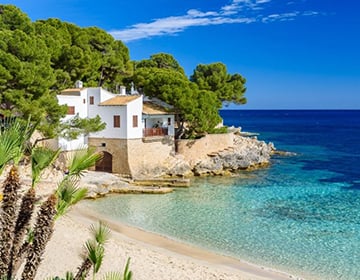As we are in 2025, Spain’s real estate landscape is evolving with economic changes, new buyer habits, and tech-driven innovation. With everything from rising sustainability standards to digital tools transforming the way properties are bought and sold, it's clear that the future of the Spain property market is not just about location anymore. It’s also about adaptation, efficiency, and long-term value.
What's Driving Spain’s Property Market in 2025?
 The overall economic outlook in Spain is cautiously positive. In 2025, GDP is expected to grow by around 2.5%, putting Spain ahead of many other Eurozone countries. This growth is helped by lower energy prices, better infrastructure, and strong tourism and service sectors.
The overall economic outlook in Spain is cautiously positive. In 2025, GDP is expected to grow by around 2.5%, putting Spain ahead of many other Eurozone countries. This growth is helped by lower energy prices, better infrastructure, and strong tourism and service sectors.
Thanks to these factors, property investment in Spain continues to increase. Experts expect total real estate investment to reach €16 billion this year. That’s more than the yearly average between 2015 and 2019. Investors are showing interest in big cities like Madrid and Barcelona, as well as in fast-growing cities like Málaga and Valencia. Alongside this economic momentum, buyer priorities are also evolving, especially when it comes to sustainability.
A Green Shift in the Spain Housing Market
One of the key changes in the Spain housing market is the growing focus on sustainability. The push for renewable energy in Spain, especially solar power, is starting to change how new homes are built. To follow EU rules, developers are now adding solar panels, water-saving systems, and energy-efficient insulation as standard features.
This trend makes Spanish homes with high energy ratings more attractive to eco-conscious buyers, especially from countries like Germany, the UK, and the U.S. Even older properties are being upgraded to meet green standards, opening up new investment opportunities. As the housing sector goes greener, technology is also reshaping how people buy, sell, and interact with real estate.
How Tech and Digital Tools Are Changing Real Estate in Spain
 Digital transformation in Spain is making property deals faster, easier, and more transparent. User-friendly platforms now allow buyers to explore property for sale in Spain from anywhere. Virtual tours, online paperwork, and smart tools help people handle everything remotely, especially useful for international buyers.
Digital transformation in Spain is making property deals faster, easier, and more transparent. User-friendly platforms now allow buyers to explore property for sale in Spain from anywhere. Virtual tours, online paperwork, and smart tools help people handle everything remotely, especially useful for international buyers.
In 2025, Spain's tech industry is set to attract over €100 billion in investment, especially in areas like AI, robotics, and IoT. As a result, there’s a growing need for modern offices and tech-friendly homes. Companies are looking for smart buildings with energy-saving systems, high-speed connections, and flexible layouts.
This trend is driving change in both real estate in Spain and city planning. Places like Barcelona and Málaga are already seeing a rise in tech hubs and digital communities, making them hotspots not just for tourism but also for long-term living and working.
While technology is transforming the way people access property, broader economic factors like inflation and financing options continue to play a critical role in shaping the market.
Inflation and Mortgage Landscape in Spain
Inflation in Spain dropped to 2.8% by the end of 2024 but remains a key concern. Even with economic pressures, real estate has shown strong resilience. That’s why many still see it as a good way to protect wealth.
After a tough period in 2023, mortgage conditions have improved. Lower interest rates are making purchasing property in Spain more attractive again. In cities like Madrid and Barcelona, prices remain high, but suburbs and smaller towns are offering better value. This gives more options to both local buyers and foreign investors. This price difference often reflects broader regional shifts in Spain’s cost of living and daily expenses, especially between large cities and more affordable suburbs.
Real Estate Market Transformation in Spain: From Urban Core to Coastlines
 If we look at Spain property price trends, we see stability in top locations and growth in others. In central Madrid, some areas still cost over €7,600 per square meter. But in places like Torrevieja, Orihuela Costa, or Pilar de la Horadada, prices are much lower—often between €1,500 and €3,000 per square meter.
If we look at Spain property price trends, we see stability in top locations and growth in others. In central Madrid, some areas still cost over €7,600 per square meter. But in places like Torrevieja, Orihuela Costa, or Pilar de la Horadada, prices are much lower—often between €1,500 and €3,000 per square meter.
Many foreign buyers are focusing on these coastal towns, especially for second homes or holiday rentals. In fact, over 93,000 properties were sold to foreigners in 2024, with strong demand expected to continue this year.
Coastal areas like Costa Blanca South remain popular thanks to good weather, improved infrastructure, and rising rental returns. These regions offer great options for those seeking value and lifestyle together.
What to Expect from Spain’s Real Estate in 2025
Overall, the real estate trends in Spain show a shift toward smarter, greener, and more flexible living. Demand is strong in both big cities and coastal towns. Spain property price trends point to moderate but steady growth, with prices expected to rise by about 5.3% this year.
Tech, sustainability, and changing lifestyles are shaping the future. Platforms that support digital transformation in Spain are making things easier for both local and international buyers. Meanwhile, energy-efficient Spanish homes and smart buildings are setting new standards for the industry.
Smart Strategies for 2025 Buyers
 Experts, especially long-term investors, agree that 2025 is a good time to buy property in Spain thanks to favorable market conditions.Not sure where to start? Here are some practical tips for navigating the Spain real estate market in 2025:
Experts, especially long-term investors, agree that 2025 is a good time to buy property in Spain thanks to favorable market conditions.Not sure where to start? Here are some practical tips for navigating the Spain real estate market in 2025:
- Take advantage of lower interest rates. Mortgage conditions have improved compared to last years, making purchasing property in Spain more affordable for both locals and foreign investors.
- Look for energy-efficient new builds. These modern Spanish homes not only meet current sustainability standards but also offer long-term savings and higher resale value.
- Explore coastal regions with growing demand. Areas like Costa del Sol, Costa Blanca South, and Alicante remain top choices thanks to their tourism potential and rental returns.
- Keep an eye on rising cities like Valencia and Málaga. These cities offer a good balance of infrastructure, lifestyle, and price, perfect for mid- to long-term investment.
- Use digital tools to research and compare. Thanks to digital transformation in Spain, buyers can now browse property for sale in Spain, track price trends, and even complete parts of the purchase process online.
- Think long-term value, not just short-term returns. With steady Spain property price trends and strong rental demand, investing in quality real estate now can lead to solid returns in the future.




